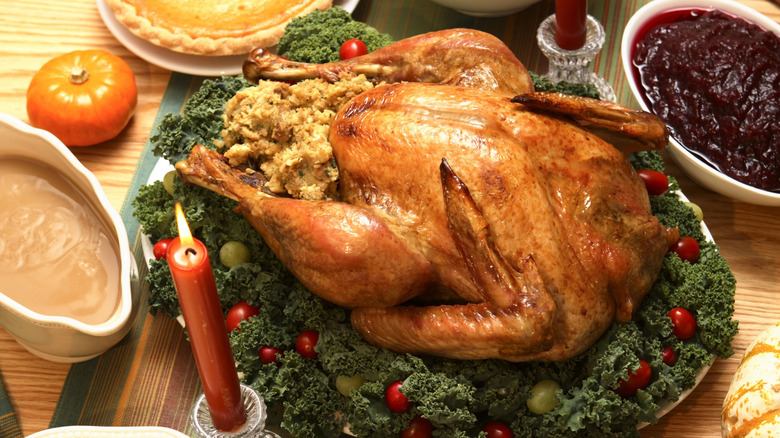The One Thing You Should Never Do When Roasting Whole Chicken
While there may be controversy between wet brining versus dry brining or dry rubs versus marinades, there's one thing you should never do when roasting a whole chicken. In an interview with Tasting Table, Chef Bradley Borchardt, Strategic Account Chef for Cargill Protein, warns against the perils of roasting whole chicken with stuffing.
"I don't recommend cooking any bird with a stuffing," Borchardt says. "It can be done but it also can be a nightmare for food borne bacteria. Better to make your stuffing in a casserole dish on the side."
While stuffing chicken sounds like a more efficient way to make two dishes in one roasting pan, the chicken's small chest cavity inhibits even cooking, leaving many parts of the stuffing raw. Produce and eggs in traditional stuffing recipes may contain harmful bacteria like salmonella or E. coli. Not only is uneven cooking dangerous, but the cooking time and internal temperatures for roasting chicken pose additional risks.
Roast chickens need to reach an internal temperature of 165 degrees Fahrenheit, which takes only about an hour to achieve. Chicken juices and the cavity itself maintain a moist environment, which is the prime environment for bacterial growth. The meat reaches 165 degrees in an hour without taking into account that the stuffing inside may need more time to reach the same temperature. If you take the bird out before the stuffing finishes cooking, the food borne bacteria nightmare Borchardt alludes to will become a reality.
Chicken vs turkey
Of course, stuffing turkey is a classic tradition that works despite comparable cooking temperatures. However, turkeys are significantly larger than chickens, with a much bigger cavity that equates to more even heat flow and consequently more even and thorough cooking. Plus, cooking times for even the smallest turkeys are at least two hours, many upwards to four or five. Despite longer cooking times and a larger cavity, even turkey stuffings come with their own warnings from the USDA of the potential for bacteria growth. If you do decide to stuff your turkey, use a meat thermometer to ensure it has reached 165 degrees Fahrenheit.
Considering the relatively small size of a chicken, you wouldn't get much stuffing in them anyways. Sticking to a casserole dish is a safer bet both for avoiding food borne illnesses and providing plenty of stuffing for everyone. We've got plenty of delicious stuffing recipes to make in your next casserole dish like this chorizo cornbread stuffing or this sourdough and sausage stuffing.
If you're looking for safer ways to add more flavor to your roast chicken, you can still stuff it. Add whole aromatics like onions, celery, and garlic, vegetables like carrots, and sprigs of fresh herbs. These veggies will cook and infuse the chicken with rich tasting notes, and you can repurpose the stuffing by adding it to a homemade chicken stock. Use the chicken stock to make or reheat your stuffing to bring things full-circle.

